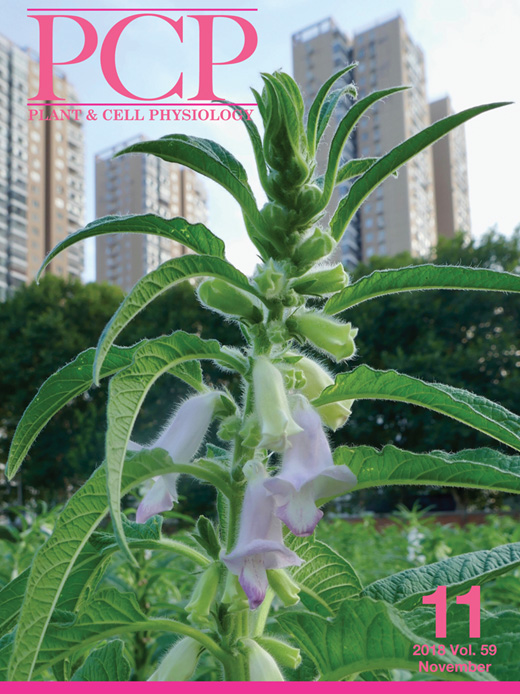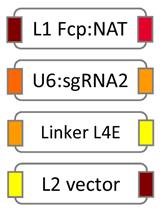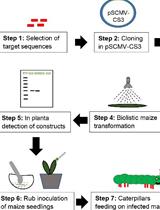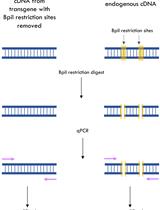- EN - English
- CN - 中文
Multiple Modification of Chromosomal Loci Using URA5.3 Selection Marker in the Unicellular Red Alga Cyanidioschyzon merolae
在单细胞红藻 Cyanidioschyzon merolae中利用URA5.3选择标记对染色体基因进行多重修饰
发布: 2019年04月05日第9卷第7期 DOI: 10.21769/BioProtoc.3204 浏览次数: 5861
评审: Dennis J NürnbergGeneviève BallJuan Facundo Rodriguez Ayala
Abstract
The unicellular red alga Cyanidioschyzon merolae has been used as a eukaryotic photosynthetic model for various basic and applied studies. Although the nuclear genome of C. merolae can be modified by homologous recombination with exogenously introduced DNA, it has been difficult to modify multiple chromosome loci within the same strain because of the limited number of available positive selection markers. Recently, we reported a modified URA5.3 gene cassette (URA5.3T), which can be used repeatedly for nuclear genome transformation using the pMKT plasmid vectors for epitope tagging (3x FLAG- or 3x Myc-) of nuclear-encoded proteins. In addition, these plasmid vectors can also be used to knock out multiple genes one by one. This report describes the construction of DNA fragments for transformation and the detailed transformation procedure.
Keywords: Cyanidioschyzon merolae (Cyanidioschyzon merolae)Background
The standard method of transformation in C. merolae uses the uracil-auxotrophic strains M4 (Minoda et al., 2004) or T1 (Taki et al., 2015), which harbor a frameshift or a complete deletion mutation in the gene URA5.3 (CMK046C). The gene URA5.3 encodes a protein composed of an orotate phosphor ribosyl transferase (OPRTase) domain and an orotidine-5'-phosphate decarboxylase (OMPdecase) domain, which synthesizes uridine-5'-monophosphate from orotate. The transformant is selected by introducing URA5.3 as a selection marker into the uracil-auxotrophic strain. A recent study has reported the chloramphenicol resistance CAT gene as a second selectable marker gene for the nuclear transformation experiment in C. merolae (Fujiwara et al., 2017). However, it is difficult to modify more than three genome loci. Thus, we developed the URA5.3 selection marker gene recycling system using a modified URA5.3 gene, named URA5.3T (Takemura et al., 2018). The URA5.3T includes the URA5.3 terminator sequence (462 bp) at the 5’ end of the URA5.3 promoter-terminator cassette to make homologous repeats, the epitope tag region which encodes the recognition sequence for three different proteases (TEV, Factor Xa and thrombin), and a 3x FLAG or 3x Myc tag-encoding sequence (Figure 1). The URA5.3 promoter-terminator cassette is eliminated by frequently occurring DNA excision through the homologous repeat sequences located on both sides of URA5.3T. In this method, the URA5.3 eliminated transformant is selected using 5-fluoroorotic acid (5-FOA), which is converted to cytotoxic 5-fluorouracil via URA5.3 activity. The marker-eliminated transformant can be used for the next round transformation experiment using the URA5.3T marker gene (Figure 1). In this report, we present the procedure for construction of the transformation template DNA, which includes the recycling marker URA5.3T, for the purpose of gene tagging or gene knock out.
Figure 1. Outline from transformation to URA5.3 marker elimination using URA5.3T. The DNA includes the homologous regions for the genome-specific locus (grey box) and the URA5.3T. The URA5.3T includes the epitope tag region, a homologous repeat sequence (red hatched box) and the URA5.3 promoter-terminator cassette. The epitope tag region contains the recognition sequence for three different proteases (TEV, Factor Xa and thrombin) and a 3x FLAG or 3x Myc tag-encoding sequence.
Materials and Reagents
- Pipette tips (NIPPON Genetics Co., Ltd., catalog numbers: FG-102, FG-301, FG-401)
- Toothpicks
- Cuvettes (As One Corporation., catalog number: 1-2855-02)
- 1.5 ml Microtube (BM Equipment Co., Ltd., catalog number: NT-175)
- 50 ml Centrifuge tube (Corning Incorporated, catalog number: 352196)
- 24-well tissue culture test plate (BM Equipment Co., Ltd., catalog number: 92424)
- Sterilized plastic plate (Φ 90 mm) (As One Corporation, catalog number: GD90-15)
- AnaeroPouch (Mitsubishi Gas, catalog number: 2-3764-02)
- AnaeroPack (Mitsubishi Gas, catalog number: 2-3765-01)
- C. merolae T1 strain (Taki et al., 2015)
- Escherichia coli DH5α (Takara Bio, catalog number: 9057)
- Wild type C. merolae DNA
- Salmon sperm DNA (FUJIFILM Wako Pure Chemical Industries Corporation, catalog number: 047-17322)
- Plasmid vector pMKT (Takemura et al., 2018; available upon request to authors)
- KOD-Plus-Neo DNA polymerase (Toyobo, catalog number: KOD-401)
- GoTaq DNA polymerase (Promega, catalog number: M7123)
- StuI (NEB, catalog number: R0187S)
- DpnI (Takara Bio, catalog number: 1235A)
- Specific primers [set for amplifying the Upstream and Downstream fragments with the homologous sequence for the StuI-digested pMKT (see Figure 2A), ordered at Integrated DNA Technologies (IDT) Inc.]
- Confirmation primer sets (annealing to the outside sequence of the homologous regions, see Figure 3, ordered at Integrated DNA Technologies (IDT) Inc.)
- Primer sets for colony PCR (ordered at Integrated DNA Technologies (IDT) Inc.):
Forward primer for up: 5’-CGAGGTCGACGGTATCGATAAGC-3’
Reverse primer for up: 5’-GATCTAGTAACATAGATGACACCGC-3’
Forward primer for down: 5’-GCTGCTAGGGATTGTGGCGCGA-3’
Reverse primer for down: 5’-CCGCTCTAGAACTAGTGGATCCC-3' - In-fusion HD cloning kit (Takara Bio, catalog number: 639648)
- Phenol, Crystals (FUJIFILM Wako Pure Chemical Corporation, catalog number: 169-22445)
- Chloroform (FUJIFILM Wako Pure Chemical Corporation, catalog number: 035-02616)
- Isoamyl alcohol (3-Methyl-1-butanol) (FUJIFILM Wako Pure Chemical Corporation, catalog number: 135-12015)
- Trizma® base Primary Standard and Buffer, crystalline (Sigma-Aldrich, catalog number: T1503-500G)
- HCl (FUJIFILM Wako Pure Chemical Corporation, catalog number: 081-03475)
- Sodium dodecyl sulfate (SDS) (FUJIFILM Wako Pure Chemical Corporation, catalog number: 194-13985)
- NaOH (FUJIFILM Wako Pure Chemical Corporation, catalog number:199-4895)
- 8-quinolinol (FUJIFILM Wako Pure Chemical Corporation, catalog number: 178-00752)
- Agarose ME (Iwai Chemical Company, catalog number: 50013R)
- Wizard SV gel and PCR clean-up system (Promega, catalog number: A9281)
- Polyethylene glycol 4000 (FUJIFILM Wako Pure Chemical Corporation, catalog number: 5322-68-3)
- Cornstarch (Kawamitsu-Bussan, catalog number: 4901 486 02701 6)
- Top starch solution (Takemura et al., 2019)
- Gellan gum (FUJIFILM Wako Pure Chemical Corporation, catalog number: 073-03071)
- Uracil (Sigma-Aldrich, catalog number: U0750-5G)
- 5-Fluoroorotic acid monohydrate (5-FOA) (FUJIFILM Wako Pure Chemical Corporation, catalog number: 066-03663)
- Sodium acetate (FUJIFILM Wako Pure Chemical Corporation, catalog number: 190-01071)
- Ethanol (FUJIFILM Wako Pure Chemical Corporation, catalog number: 055-00457)
- (NH4)2SO4 (FUJIFILM Wako Pure Chemical Corporation, catalog number: 019-03435)
- MgSO4∙7H2O (FUJIFILM Wako Pure Chemical Corporation, catalog number: 138-00415)
- H2SO4 (FUJIFILM Wako Pure Chemical Corporation, catalog number: 192-04696)
- H3BO3 (FUJIFILM Wako Pure Chemical Corporation, catalog number: 021-02195)
- MnCl2∙4H2O (FUJIFILM Wako Pure Chemical Corporation, catalog number: 133-00725)
- ZnCl2 (FUJIFILM Wako Pure Chemical Corporation, catalog number: 268-01022)
- Na2MoO4∙2H2O (FUJIFILM Wako Pure Chemical Corporation, catalog number: 198-02471)
- CoCl2∙6H2O (FUJIFILM Wako Pure Chemical Corporation, catalog number: 038-03681)
- CuCl2∙2H2O (FUJIFILM Wako Pure Chemical Corporation, catalog number: 039-04135)
- KH2PO4 (FUJIFILM Wako Pure Chemical Corporation, catalog number: 169-04245)
- CaCl2∙2H2O (FUJIFILM Wako Pure Chemical Corporation, catalog number: 038-19735)
- FeCl3∙6H2O (FUJIFILM Wako Pure Chemical Corporation, catalog number: 090-02802)
- Na2EDTA (FUJIFILM Wako Pure Chemical Corporation, catalog number: 345-01865)
- DNA solution (see Recipes)
- PEG solution (see Recipes)
- MA2 medium (Kobayashi et al., 2010, see Recipes)
- MA2 solution I
- A6 minor salts
- MA2 solution II
- MA2 solution III
- MA2 solution IV
- MA2 solid gellan gum plate (see Recipes)
- DNA extraction buffer (see Recipes)
- Neutralized phenol (see Recipes)
Equipment
- Pipettes (Gilson, Inc., catalog numbers: F123600, F123601, F123602)
- Refrigerated centrifuge (Koki Holdings Co., Ltd., model: CF16RXII)
- Microcentrifuge (TOMY Seiko Co., Ltd., model: MX150)
- 500 ml flask (IWAI, catalog number: 4442FK500)
- Heat Block (Chiyoda Science Co., Ltd., model: MiniT-100)
- Bio incubator (TOMY Seiko Co., Ltd., model: CLE-303)
- NanoDrop (Thermo Fisher Scientific Inc., model: ND-LITE)
- Thermal Cycler (Bio-Rad Laboratories, Inc., model: T100 Thermal Cycler)
- Electrophoresis apparatus (Atto Corporation, model: WSE-1710)
- FAS gel imager (Nippon Genetics Co., Ltd., model: FAS-IV)
- Spectrophotometer (Beckman coulter, Inc., model: DU730, A23616)
Procedure
文章信息
版权信息
© 2019 The Authors; exclusive licensee Bio-protocol LLC.
如何引用
Takemura, T., Imamura, S., Kobayashi, Y. and Tanaka, K. (2019). Multiple Modification of Chromosomal Loci Using URA5.3 Selection Marker in the Unicellular Red Alga Cyanidioschyzon merolae. Bio-protocol 9(7): e3204. DOI: 10.21769/BioProtoc.3204.
分类
微生物学 > 微生物遗传学 > 基因组编辑
植物科学 > 藻类学 > DNA > 基因组编辑
分子生物学 > DNA > DNA 克隆
您对这篇实验方法有问题吗?
在此处发布您的问题,我们将邀请本文作者来回答。同时,我们会将您的问题发布到Bio-protocol Exchange,以便寻求社区成员的帮助。
Share
Bluesky
X
Copy link














